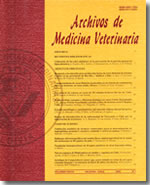Cryopreservation of bovine spermatozoa from the epididymal tail using conventional and automated methods
Main Article Content
Abstract
Cryopreservation of sperm is important to preserve the germplasm from animals of genetic value, which can die unexpectedly. This study compares conventional and automated methods of cryopreservation of spermatozoa obtained from the epididymis of bulls post-mortem. Twenty-two epididymides were obtained from a commercial slaughterhouse. Spermatozoa were collected from the tail of the epididymis using the retrograde flow technique. Thus, the samples, which were diluted in 10 ml of extender without glycerol (Botubov® I, Botupharma, Botucatu, SP, Brazil), were evaluated on motility, sperm vigor, structural and functional (swelling hypoosmotic test) membrane integrity, mitochondrial activity, sperm viability and ADN fragmentation. The samples were divided into two aliquots and diluted in extender with glycerol (Botubov® II, Botupharma, Botucatu, SP, Brazil) at a concentration of 50x106 motile sperm/0.5 French straws. One sample was frozen by the conventional method (4 hours at 5°C, in a refrigerator and 20 min in nitrogen vapor) and the other by the automated method (Cryogen® Dualflex, Neovet, Uberaba, MG, Brazil). The parameters were higher in all the tests of fresh sperm samples, with the exception of the swelling hypoosmotic test, which showed no significant difference when the results were compared with sperm frozen by the conventional method. The average motility of fresh spermatozoa was 74%, and conventional and automated averages were 29 and 25%, respectively. Therefore, although cryopreservation techniques reduce sperm quality parameters, the viability of the sperm is maintained, and these methods can be used to preserve sperm.

